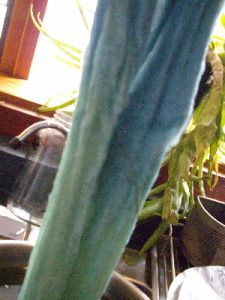The indigo achieved from woad is molecularly identical to that achieved from tropical indigo. However, the colour achieved is lighter, and more variable in woad than in tropical indigo.
Dying Directly from the Extraction Vat
After extraction the vat should be re-heated to around body temperature, or just over, and the pH checked. For the best blues the pH should remain near ten. If the vat is left for a few days, it will ferment and the pH will drop. Washing Soda is a mild alkaline and works well for shifting the pH back up.
To reduce the vat, a 4 liter vat should have 2 table spoons of Thiourea Dioxide added. The Thiourea dioxide reduces the vat through the removal of oxygen. After the Thiourea Dioxide is added, the vat should sit for around 30 min. to fully reduce.
After reduction is complete your woad vat is ready for dying.
Dyeing with Woad or Indigo: the Revating method
Most natural dyes require you to have a ratio of dye to fibre to achieve the desired colour. Indigo is different, a small amount of dye can give you a dark and exceptionally fast colour. At the same time, a large amount of dye, used differently, can give you a bleeding and unsatisfactory colour. The difference lies in the indigo molecule.
The indigo molecule forms a physical bond with the fabric when taken from the reduced vat into the air. When fabric is re-vatted a second layer of colour molecules build up. This creates a deeper, richer, and more permanent colour. The darkest colours are usually obtained after 4 re-vattings, fifteen minutes in and fifteen minutes out. Lighter colours can be obtained through shorter vattings. The chemical structure of indigo is more fully explained in my previous article on why indigo is a different dye.
When indigo is not revatted, the single layer of molecules will be susceptible to friction. This will rapidly fade the dyed fibre, and can be disappointing. It is also likely to stain your skin, if you are wearing the dyed fibre next to it, or spinning fiber dyed loose in the vat.
Other Colours from the Indigo Extraction Vat
It is possible to get purple, green, and reddish colours from the woad indigo vat.
Green is frequently achieved from the woad extraction vat, rather than a pure blue. If green is not desired, the colour can be changed by neutralizing the alkalinity of the fiber. The green will change to blue. A light vinegar rinse works well.
Purple can be obtained by dying with the extraction vat at a pH of 8. The lower pH does not fully reduce the indigo molecules, but does reduce the “indiruben” or indigo red molecules. This causes the difference in shade.
A reddish shade can be obtained by dying at a pH of 7. This permits the indiruben to be fully reduced while not reducing the indigo molecules. The colour is permanent.
If the vat ferments gray can also be obtained. This is done by reducing the fermented vat, without changing the pH. The pH should be lower than a seven for gray to be obtained. And yes, I found this one out by accident.
Back To You:
Have you had a woad dye vat that did not work? Did you get a colour you were not expecting from indigo or woad? I would love to hear from you. Leave a comment.

[…] or natural dye variation, when it can be used as a design element? This is particularly true when dying with natural indigo, or natural woad […]